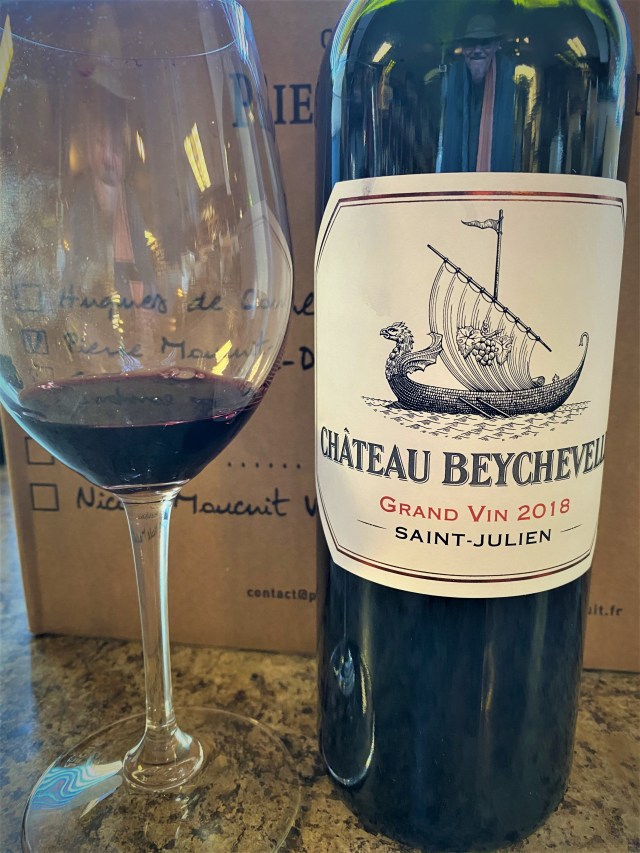Once again, the Gods smiled upon me, when I wandered into my local wine shop the Fine Wine Source and they included me, in their private wine tasting for the store and in anticipation of opening up their restaurant in the future. I know that they are looking forward to actually having some formal wine tastings in the shop, like the old days and I know that I and the rest of their loyal fans are waiting for that day as well. They are responding as well as they can, by booking private one on one tastings with their customers and keeping the customers safe with social distancing. To achieve this, they actually removed part of their elaborate wine rack that you used to encounter as you first entered into the shop. That day, I actually had a chance to try some time-honored wines that in fifty years I had never had a chance to try and enjoy from the famed Classification of 1855 for the Medoc.

It was a pleasure to have the Chateau Beychevelle Saint-Julien 2018. The estate has a name that evolved from a nautical tribute by the boats on the Garonne as they passed the home, which in the 17th Century was owned by the First Duke of Epernon, a Navy Admiral. As the boats would pass the estate, they would lower their sails in deference to the Admiral and that gesture is “Baisse-Voile” which translates to “lower the sails” and in Gascon it is pronounced “Becha Vele” and evolved into Beychevelle. The estate has two-hundred-fifty hectares of vineyards, the bulk being in the Saint-Julien appellation and sixty-two percent is planted to Cabernet Sauvignon, thirty-one percent to Merlot, five percent to Cabernet Franc and two percent to Petit Verdot and all planted on the deep Garonne gravel. Chateau Beychevelle is a Fourth Growth, and they also have a second label Amiral de Beychevelle from plots not designated for the main wine. They have a third label from the wine that is made from the plots that are not in the Saint-Julien appellation and this wine is Les Brulieres de Beychevelle and has the appellation of Haut-Medoc. While there are no First Growths in Saint-Julian there are eleven classified growths, which accounts for seventy-five percent of the commune, as they are sandwiched between Pauillac and Margaux. This was a more unique vintage for Chateau Beychevelle as the wine was fifty percent Merlot, forty-one percent Cabernet Sauvignon, six percent Petit Verdot and three percent Cabernet Franc. The wine is aged for eighteen months in oak barrels, of which half are new. For being a young wine, it was very balanced and rather elegant with notes of both red and black fruits, fruit forward with silky tannins and a nice leisurely finish.

Chateau Lynch-Bages Pauillac 2018 is respected and lauded as one of the best of the Fifth Growths from the Classification of 1855 for the Medoc. The estate is in the Commune of Pauillac in the village of Bages and was founded by and owned by Thomas Lynch, a Bordeaux merchant of Irish descent from 1749 to 1824. In 1939, Jean-Charles Cazes who had managed the property as a tenant farmer since 1933, acquired Chateau Lynch-Bages. The estate has been in the Cazes family ever since, and they have gone on to acquire other properties in Bordeaux and through their Michel Lynch brand are also in Minervois and Chateauneuf-du-Pape in France and in a partnership of Roquette & Cazes in Portugal. The estate encompasses ninety hectares of vineyard, of which seventy-five percent is Cabernet Sauvignon, the balance is Merlot, Cabernet Franc and a small amount of Petit Verdot. They also produce a second label Echo de Lynch-Bages, and a very rare white blend Blanc de Lynch-Bages AOP Bordeaux from six hectares in eight different vineyard parcels on the west of the estate. Fermentation begins in Stainless Steel with extensive pumping of the juice for concentration and color. The wine is aged for about fifteen months in oak, of which roughly two-thirds of the barrels are new. The estate has an old bat-house that has a traditional gravity-flow design that is still copied to this day, by other wineries. The wine was an excellent, classic example of Pauillac and it belies its Fifth Growth status and could possibly fool plenty in a blind tasting. It was layered and nuanced, even in its youth, but the wine is known for its long life, so cellaring will definitely enhance the wine, if one is so inclined.
